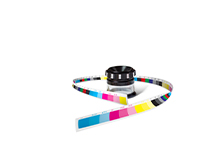Humidification in print shops
Even if reading has gone a little out of fashion, paper is still in demand as a raw material. Paper is required not only for newspapers and books, but also for parcels, packaging, insulating material, bank notes, and furniture. To avoid corrugated cardboard beds collapsing, to ensure packaging material provides safe protection, and so documents remain intact, paper and printed products must be stored and processed correctly.
Maximum precision and perfect humidity are required if newspapers are to be rattled off the rotary offset press at 55 km/h.
Paper is hygroscopic
Hygroscopic materials are substances that can trap moisture in their cell structure. At low humidity, the air extracts moisture from the materials, often damaging the cell structure and causing cracks to form.
Static charges
Static charge can occur on unearthed production equipment, or on the textiles themselves.
At a relative humidity of 50–55%, damp air increasingly settles on ions, making them heavier and less mobile in the electric field. The conductivity of the air and the material surfaces then increases, so that electrical charges are dissipated, which prevents the formation of potential differences.
 Dry air below 40% RH can cause
Dry air below 40% RH can cause electrical potential differences
 At 50–55% RH, electrical charges can dissipate
At 50–55% RH, electrical charges can dissipatedue to the increased conductivity

Perfect printing results
For the highly sensitive rotary printing facilities, the air humidity must be kept at a constant level of 60 percent at ambient temperatures of 20–25 degrees Celsius. If the ambient air is too dry, this increases the error probability and also shortens the service life of the printing presses. High-precision humidification also avoids the negative effects of static electricity and prevents any possible impact on the printing processes, such as misalignment or paper jams.

Preventing dust ingress
No matter whether offset, digital, rotary or package printing: For print shops, it is essential to guarantee optimum humidity for both product and production quality. For example, electrostatic charging caused by excessively dry air attracts dust from the environment and thus impairs the quality of the printed products and printing presses. With a humidity of 45–55 percent in the respective rooms, however, even the finer dust particles in the air are moistened. The moisture binds the dust, which consequently becomes heavier, sinks to the ground or does not rise into the air at all. Papers that are kept in too dry conditions also tend to generate dust themselves. In the process, fibers are released from the paper, combine and can therefore impair ink transfer and thus the quality of the printed image as a whole.

Storage of coated paper


Storage of uncoated paper


Storage of books


Photo printing


Screen printing


Szklarnie
Aby uzyskać optymalne plony i zminimalizować ryzyko inwazji szkodników, wilgotność w szklarniach musi być regulowana. Każdy gatunek rośliny ma swoją ...

Hammam, Caldarium i Rhassoul
Hamam to łaźnia parowa, w której odbywa się specjalna ceremonia kąpieli,
i jest ważną częścią islamskiej kultury kąpielowej i fizycznej.
Skupia się...

Łaźnia parowa i prysznic parowy
W dzisiejszych czasach wiele hoteli i klubów zdrowia oferuje zaplecze spa dla dobrego samopoczucia swoich gości i członków:
Basen, sauna, a coraz czę...

Steam bath and steam shower
Nowadays, many hotels and health clubs offer spa facilities for the well-being of their guests and members:
A swimming pool, a sauna and more and mor...

Centrum telefoniczne
Dobra wilgotność powietrza w call center zapewnia nie tylko dobre samopoczucie pracowników, lecz również ich wydajność i zdrowie.Choroby układu oddec...

Muzea
Muzea są skarbcem chroniącym dzieła sztuki i inny dorobek ludzkości. Niezliczone,
często unikalne i niezastąpione eksponaty, są warte wiele miliardó...

Lotnictwo
W branży lotniczej niezbędna jest niezawodna funkcjonalność wszystkich komponentów. Niedostateczna wilgotność może prowadzić do uszkodzeń i usterek e...

Magazynowanie
Wszędzie tam, gdzie przechowywane są produkty i towary lub archiwizowane są dokumenty, kompleksowe osuszanie powietrza chroni przed potencjalnym szko...

Pływalnie
Wysoki poziom parowania wody na pływalniach, szczególnie w połączeniu z panującymi tam wysokimi temperaturami w pomieszczeniu, prowadzi do ogromnego ...

Przemysł drzewny
Drewno to naturalny materiał, który „żyje” długo po ścięciu drzewa. Jeżeli podczas składowania i przetwarzania powietrze jest zbyt suche, drewno trac...

